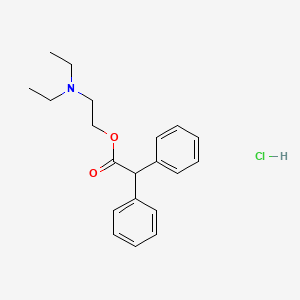Adiphenine Hydrochloride
- Adiphenine hydrochloride
- 50-42-0
- ADIPHENINE HCL
- Patrovina
- Spasnil
- Create:2005-07-28
- Modify:2025-01-11

- Adiphenine hydrochloride
- 50-42-0
- ADIPHENINE HCL
- Patrovina
- Spasnil
- Sentiv
- Trasentin hydrochloride
- Adiphenine chloride
- Vegantin
- Adiphen hydrochloride
- Difacil hydrochloride
- Adifenin hydrochloride
- Adiphenine (hydrochloride)
- Diphacil hydrochloride
- Trasentine hydrochloride
- Transentine hydrochloride
- Adipheninium chloratum
- Spasmolytin hydrochloride
- Adiphenine hydrochloride [USAN]
- 2-(Diethylamino)ethyl diphenylacetate hydrochloride
- Diphenylacetic acid 2-(diethylamino)ethyl ester hydrochloride
- Diphenylacetyldiethylaminoethyl hydrochloride
- UNII-42B4PDY0AV
- EINECS 200-036-9
- 42B4PDY0AV
- 2-(diethylamino)ethyl 2,2-diphenylacetate hydrochloride
- NSC 129224
- NSC-129224
- DTXSID0045880
- Diphenylacetate du diethylamino-ethanol chlorhydrate
- ACETIC ACID, DIPHENYL-, 2-(DIETHYLAMINO)ETHYL ESTER, HYDROCHLORIDE
- MLS000028404
- Diphenylacetate du diethylamino-ethanol chlorhydrate [French]
- Adiphenine hydrochloride (USAN)
- DTXCID8025880
- Ethanol, 2-(diethylamino)-, 2,2-diphenylacetate, hydrochloride
- ADIPHENINE HYDROCHLORIDE [MI]
- NSC129224
- ADIPHENINE HYDROCHLORIDE [MART.]
- NCGC00094995-01
- ADIPHENINE HYDROCHLORIDE [WHO-DD]
- SMR000058354
- Benzeneacetic acid, a-phenyl-, 2-(diethylamino)ethyl ester,hydrochloride
- Benzeneacetic acid, .alpha.-phenyl-2-(diethylamino)ethyl ester hydrochloride
- Benzeneacetic acid, alpha-phenyl-2-(diethylamino)ethyl ester hydrochloride
- ADIPHENINE HYDROCHLORIDE (MART.)
- CAS-50-42-0
- Diphenylacetic acid 2-(diethylamino)ethyl ester
- SR-01000000075
- Prestwick_7
- MFCD00050508
- Opera_ID_604
- Trasentine, hydrochloride
- Benzeneacetic acid, alpha-phenyl-, 2-(diethylamino)ethyl ester, hydrochloride
- REGID_for_CID_5763
- SCHEMBL33478
- MLS001076478
- MLS002222150
- SPECTRUM1503073
- Adiphenine Hydrochloride, 98%
- CHEMBL555654
- HY-B0379AR
- HY-B0379A
- LKPINBXAWIMZCG-UHFFFAOYSA-N
- HMS1568O11
- HMS1922C11
- Pharmakon1600-01503073
- WLN: 2N2&2OVYR&R &GH
- BCP22622
- Tox21_111379
- AC-013
- CCG-39173
- NSC758234
- s2082
- Adiphenine (hydrochloride) (Standard)
- AKOS015900392
- Tox21_111379_1
- NSC-758234
- NCGC00016221-06
- NCGC00094995-02
- NCGC00094995-03
- AS-15686
- DA-50237
- A2498
- Adiphenine hydrochloride, analytical standard
- Ethanol, 2,2-diphenylacetate, hydrochloride
- NS00078962
- SW196325-3
- D02772
- D88523
- 2-Diethylaminoethyl diphenylacetate hydrochloride
- SR-01000000075-4
- Q27258524
- 2-(diethylamino)ethyl 2,2-diphenylacetate;hydrochloride
- 2-(diethylamino)ethyl 2,2-diphenylacetate;hydron;chloride
- Adiphenine HCl; NSC 129224; NSC-129224; NSC129224

H302 (97.6%): Harmful if swallowed [Warning Acute toxicity, oral]
H312 (95.1%): Harmful in contact with skin [Warning Acute toxicity, dermal]
H332 (95.1%): Harmful if inhaled [Warning Acute toxicity, inhalation]
P261, P264, P270, P271, P280, P301+P317, P302+P352, P304+P340, P317, P321, P330, P362+P364, and P501
(The corresponding statement to each P-code can be found at the GHS Classification page.)
Aggregated GHS information provided per 41 reports by companies from 4 notifications to the ECHA C&L Inventory. Each notification may be associated with multiple companies.
Information may vary between notifications depending on impurities, additives, and other factors. The percentage value in parenthesis indicates the notified classification ratio from companies that provide hazard codes. Only hazard codes with percentage values above 10% are shown.
Acute Tox. 4 (97.6%)
Acute Tox. 4 (95.1%)
Acute Tox. 4 (95.1%)
IMAP assessments - Benzeneacetic acid, .alpha.-phenyl-, 2-(diethylamino)ethyl ester, hydrochloride: Environment tier I assessment
IMAP assessments - Benzeneacetic acid, .alpha.-phenyl-, 2-(diethylamino)ethyl ester, hydrochloride: Human health tier I assessment
Patents are available for this chemical structure:
https://patentscope.wipo.int/search/en/result.jsf?inchikey=LKPINBXAWIMZCG-UHFFFAOYSA-N
- Australian Industrial Chemicals Introduction Scheme (AICIS)Benzeneacetic acid, .alpha.-phenyl-, 2-(diethylamino)ethyl ester, hydrochloridehttps://services.industrialchemicals.gov.au/search-assessments/
- CAS Common ChemistryLICENSEThe data from CAS Common Chemistry is provided under a CC-BY-NC 4.0 license, unless otherwise stated.https://creativecommons.org/licenses/by-nc/4.0/Adiphenine hydrochloridehttps://commonchemistry.cas.org/detail?cas_rn=50-42-0
- ChemIDplusAdiphenine hydrochloride [USAN]https://pubchem.ncbi.nlm.nih.gov/substance/?source=chemidplus&sourceid=0000050420ChemIDplus Chemical Information Classificationhttps://pubchem.ncbi.nlm.nih.gov/source/ChemIDplus
- DTP/NCILICENSEUnless otherwise indicated, all text within NCI products is free of copyright and may be reused without our permission. Credit the National Cancer Institute as the source.https://www.cancer.gov/policies/copyright-reuse
- EPA DSSToxAdiphenine hydrochloridehttps://comptox.epa.gov/dashboard/DTXSID0045880CompTox Chemicals Dashboard Chemical Listshttps://comptox.epa.gov/dashboard/chemical-lists/
- European Chemicals Agency (ECHA)LICENSEUse of the information, documents and data from the ECHA website is subject to the terms and conditions of this Legal Notice, and subject to other binding limitations provided for under applicable law, the information, documents and data made available on the ECHA website may be reproduced, distributed and/or used, totally or in part, for non-commercial purposes provided that ECHA is acknowledged as the source: "Source: European Chemicals Agency, http://echa.europa.eu/". Such acknowledgement must be included in each copy of the material. ECHA permits and encourages organisations and individuals to create links to the ECHA website under the following cumulative conditions: Links can only be made to webpages that provide a link to the Legal Notice page.https://echa.europa.eu/web/guest/legal-noticeAdiphenine hydrochloridehttps://echa.europa.eu/substance-information/-/substanceinfo/100.000.034Adiphenine hydrochloride (EC: 200-036-9)https://echa.europa.eu/information-on-chemicals/cl-inventory-database/-/discli/details/33867
- FDA Global Substance Registration System (GSRS)LICENSEUnless otherwise noted, the contents of the FDA website (www.fda.gov), both text and graphics, are not copyrighted. They are in the public domain and may be republished, reprinted and otherwise used freely by anyone without the need to obtain permission from FDA. Credit to the U.S. Food and Drug Administration as the source is appreciated but not required.https://www.fda.gov/about-fda/about-website/website-policies#linkingADIPHENINE HYDROCHLORIDEhttps://gsrs.ncats.nih.gov/ginas/app/beta/substances/42B4PDY0AV
- Burnham Center for Chemical Genomics
- CCSbaseCCSbase Classificationhttps://ccsbase.net/
- ChEMBLLICENSEAccess to the web interface of ChEMBL is made under the EBI's Terms of Use (http://www.ebi.ac.uk/Information/termsofuse.html). The ChEMBL data is made available on a Creative Commons Attribution-Share Alike 3.0 Unported License (http://creativecommons.org/licenses/by-sa/3.0/).http://www.ebi.ac.uk/Information/termsofuse.htmlChEMBL Protein Target Treehttps://www.ebi.ac.uk/chembl/g/#browse/targets
- KEGGLICENSEAcademic users may freely use the KEGG website. Non-academic use of KEGG generally requires a commercial licensehttps://www.kegg.jp/kegg/legal.html
- NCI Thesaurus (NCIt)LICENSEUnless otherwise indicated, all text within NCI products is free of copyright and may be reused without our permission. Credit the National Cancer Institute as the source.https://www.cancer.gov/policies/copyright-reuseNCI Thesaurushttps://ncit.nci.nih.gov
- SpectraBase2-[(diphenylacetyl)oxy]-N,N-diethylethanaminium chloridehttps://spectrabase.com/spectrum/I5DLZVdoTW4Adiphenine hydrochloride salthttps://spectrabase.com/spectrum/7ucjlwgjj4L
- Springer Nature
- Wikidataadiphenine hydrochloridehttps://www.wikidata.org/wiki/Q27258524
- PubChem
- GHS Classification (UNECE)GHS Classification Treehttp://www.unece.org/trans/danger/publi/ghs/ghs_welcome_e.html
- NORMAN Suspect List ExchangeLICENSEData: CC-BY 4.0; Code (hosted by ECI, LCSB): Artistic-2.0https://creativecommons.org/licenses/by/4.0/NORMAN Suspect List Exchange Classificationhttps://www.norman-network.com/nds/SLE/
- MolGenieMolGenie Organic Chemistry Ontologyhttps://github.com/MolGenie/ontology/
- PATENTSCOPE (WIPO)SID 389067364https://pubchem.ncbi.nlm.nih.gov/substance/389067364


 CID 2031 (Adiphenine)
CID 2031 (Adiphenine) CID 313 (Hydrochloric Acid)
CID 313 (Hydrochloric Acid)